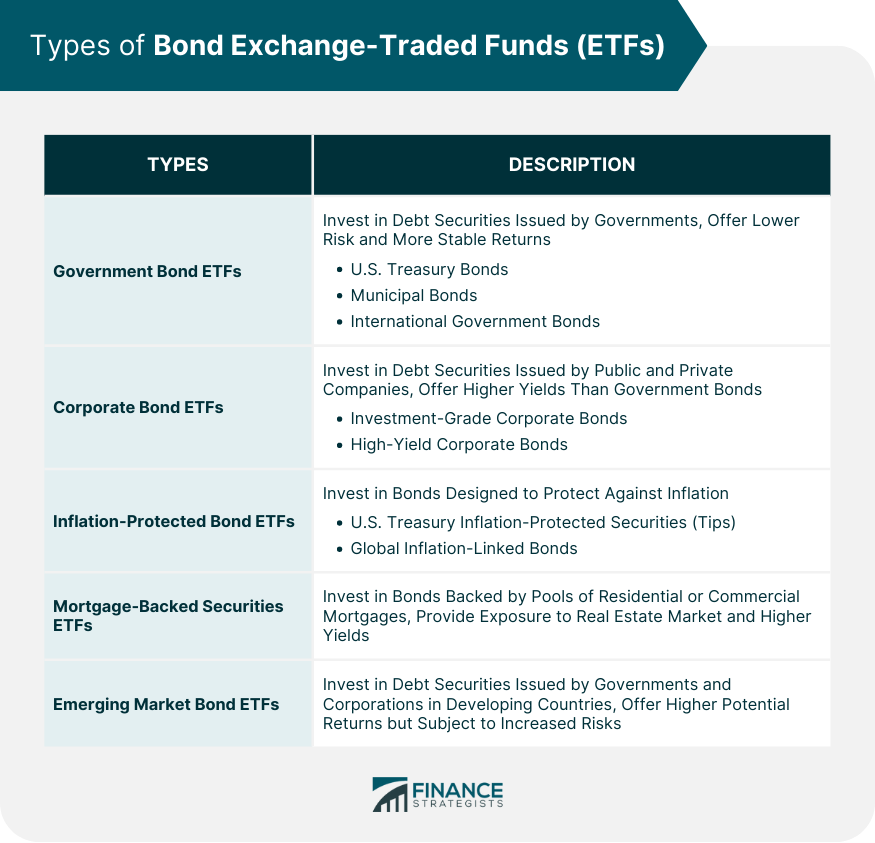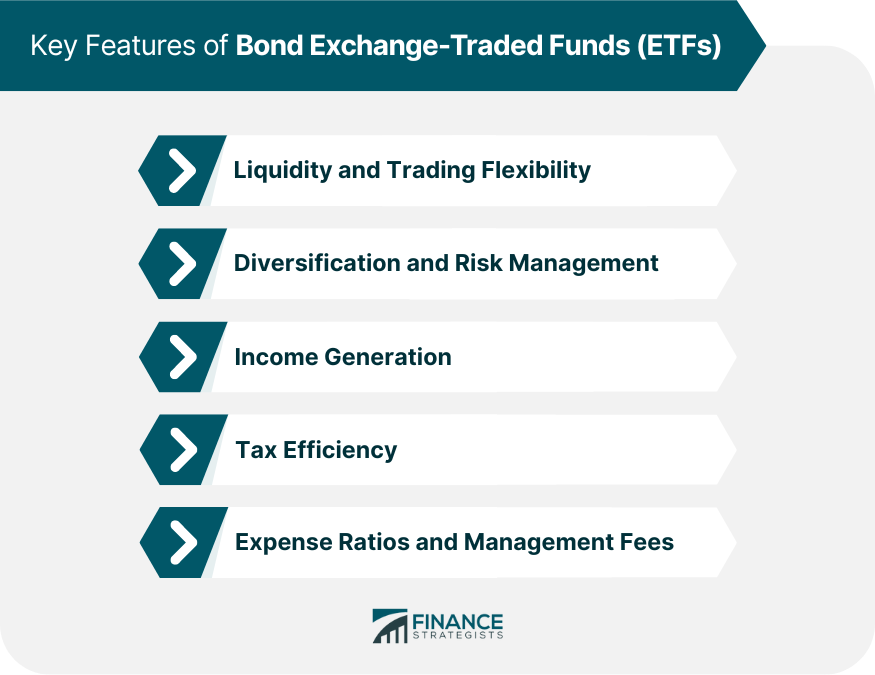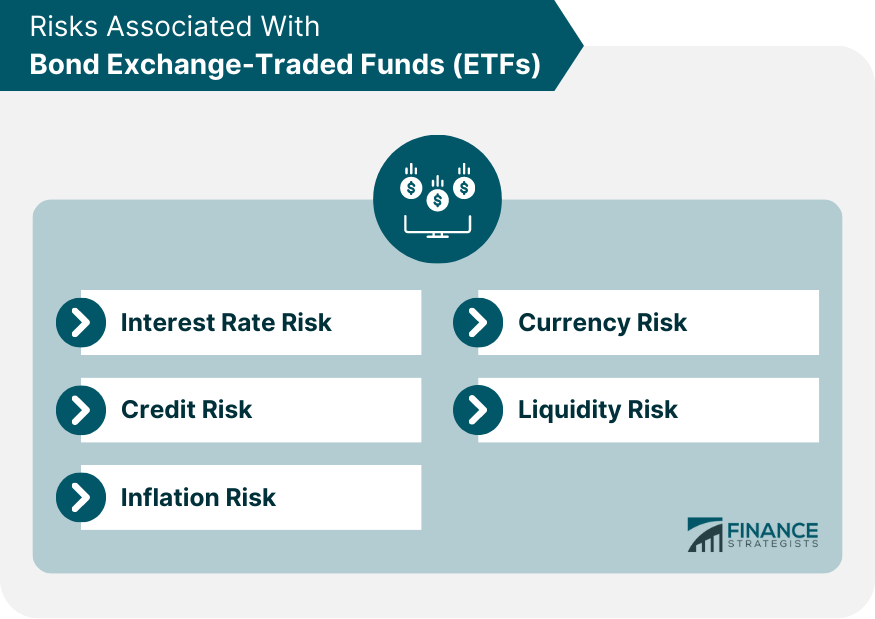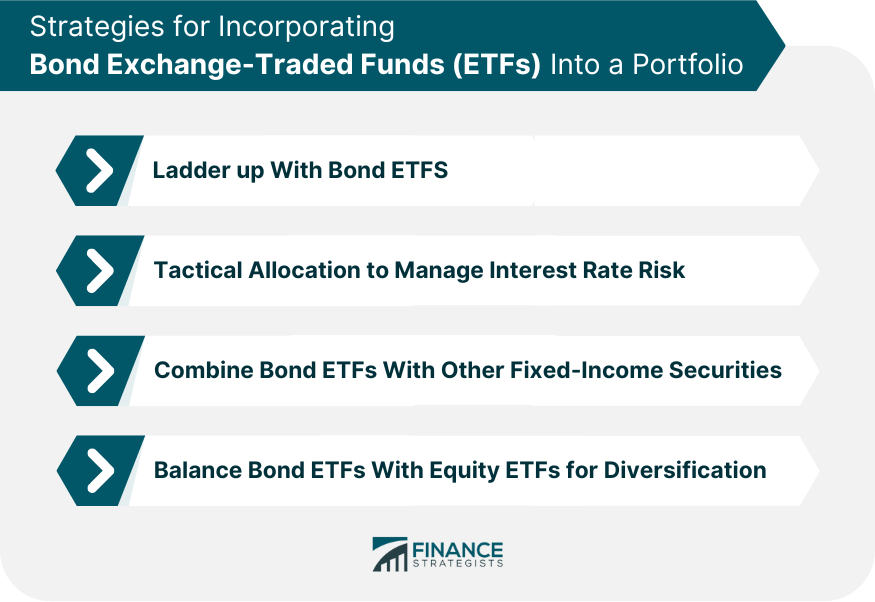A bond ETF, or bond exchange-traded fund, is an investment fund that holds a diversified portfolio of fixed-income securities, such as government bonds, corporate bonds, or municipal bonds. It is designed to track the performance of a specific bond index or bond market segment. Unlike traditional bond mutual funds, bond ETFs are traded on stock exchanges like individual stocks. This allows investors to buy and sell shares of the ETF throughout the trading day at market prices. Bond ETFs provide an efficient and transparent way for investors to gain exposure to the bond market without directly owning individual bonds. They provide instant diversification by holding a basket of bonds, reducing the impact of any single bond's performance. They also offer liquidity, as investors can easily buy or sell shares on the exchange. Additionally, bond ETFs can generate income through interest payments from the underlying bonds. Government bond ETFs invest in debt securities issued by various levels of government, including federal, state, and local governments. These ETFs typically offer lower risk and more stable returns compared to other bond ETF types, making them a popular choice for conservative investors. U.S. Treasury bond ETFs invest in debt issued by the U.S. federal government. These bonds are considered among the safest investments globally, as they are backed by the full faith and credit of the United States. Investors often turn to U.S. Treasury bond ETFs during times of economic uncertainty due to their low-risk nature. Municipal bond ETFs invest in debt securities issued by state and local governments in the United States. These bonds help fund infrastructure projects and other public services. Municipal bond ETFs are popular among income-focused investors because their interest income is generally exempt from federal income tax and, in some cases, state and local taxes. International government bond ETFs invest in debt securities issued by governments outside the United States. These ETFs provide exposure to a diverse range of global interest rates and economic conditions, which can potentially enhance risk-adjusted returns. However, they may also expose investors to currency risk, as the underlying bonds are often denominated in foreign currencies. Corporate bond ETFs invest in debt securities issued by public and private companies. These ETFs can offer higher yields than government bond ETFs but carry higher credit risk, as companies are more likely to default on their debt obligations compared to governments. Investment-grade corporate bond ETFs invest in bonds issued by companies with a relatively low risk of default, as determined by credit rating agencies. These ETFs typically offer moderately higher yields than government bond ETFs, with a lower risk profile compared to high-yield corporate bond ETFs. High-yield corporate bond ETFs invest in bonds issued by companies with a higher risk of default, as determined by credit rating agencies. These ETFs offer potentially higher yields in exchange for increased credit risk, making them more suitable for aggressive investors seeking income and capital appreciation. Inflation-protected bond ETFs invest in bonds designed to help investors protect their purchasing power against rising inflation. These bonds typically adjust their principal and interest payments in response to changes in inflation rates, providing a real return that maintains its value over time. U.S. Treasury Inflation-Protected Securities (TIPS) are government-issued bonds that protect investors against inflation by adjusting their principal value and interest payments based on changes in the Consumer Price Index (CPI). TIPS ETFs invest in these securities, providing a hedge against inflation and preserving purchasing power. They are considered low-risk investments, making them suitable for conservative investors. Global inflation-linked bond ETFs invest in inflation-protected bonds issued by governments worldwide. These ETFs offer diversification across various countries and regions, providing exposure to different inflationary environments. By investing in global inflation-linked bonds, investors can hedge against inflation in multiple economies, potentially enhancing portfolio performance. Mortgage-backed securities (MBS) ETFs invest in bonds backed by pools of residential or commercial mortgages. These ETFs offer exposure to the real estate market and typically provide higher yields than government bond ETFs. However, MBS ETFs can carry higher credit risk and may be more sensitive to interest rate changes, making them suitable for investors willing to accept moderate risk levels. Emerging market bond ETFs invest in debt securities issued by governments and corporations in developing countries. These ETFs can offer higher yields and the potential for capital appreciation but are subject to increased credit, currency, and geopolitical risks compared to developed market bond ETFs. Investors seeking exposure to faster-growing economies and higher potential returns may consider emerging market bond ETFs. Bond ETFs are traded on stock exchanges, allowing investors to buy and sell shares throughout the trading day. This liquidity and trading flexibility provide investors with the ability to respond to market events quickly and easily adjust their portfolio allocations. Bond ETFs also typically have narrower bid-ask spreads than individual bonds, reducing transaction costs. Investing in bond ETFs provides instant diversification across a broad range of fixed-income securities, helping to mitigate credit and interest rate risks. By spreading investments across various issuers, sectors, and maturities, bond ETFs can reduce the impact of any single bond default or interest rate movement on the overall portfolio. Bond ETFs generate income through interest payments from the underlying bonds in their portfolios. These payments are typically distributed to shareholders as dividends, providing a consistent income stream for investors. Bond ETFs can be an attractive option for income-seeking investors, especially during periods of low-interest rates. Bond ETFs are generally more tax-efficient than individual bonds because they are structured as open-end investment funds. This structure allows ETFs to minimize capital gains distributions by using in-kind redemptions to manage their portfolios. Additionally, certain bond ETFs, such as municipal bond ETFs, may provide tax-exempt income to investors. Bond ETFs often have lower expense ratios and management fees compared to actively managed bond mutual funds. Lower fees can translate into higher returns over time, making bond ETFs an attractive option for cost-conscious investors. However, it is essential to compare fees across different bond ETFs, as they can vary significantly. Bond prices generally move inversely to interest rates, meaning that when interest rates rise, bond prices fall, and vice versa. Bond ETFs are subject to interest rate risk, which can negatively impact their value and returns. Longer-duration bond ETFs are typically more sensitive to interest rate changes than shorter-duration ETFs. Credit risk refers to the possibility that an issuer defaults on its debt obligations, potentially leading to a loss of principal or interest for bondholders. Bond ETFs are exposed to credit risk through the bonds they hold in their portfolios. Generally, high-yield corporate bond ETFs and emerging market bond ETFs carry higher credit risk compared to investment-grade corporate bond ETFs and government bond ETFs. Inflation erodes the purchasing power of future bond payments, negatively impacting the real return on fixed-income investments. Bond ETFs, especially those with longer durations, are susceptible to inflation risk. However, inflation-protected bond ETFs can help mitigate this risk by investing in securities designed to adjust their principal and interest payments based on inflation rates. International and emerging market bond ETFs often invest in bonds denominated in foreign currencies, exposing investors to currency risk. Fluctuations in exchange rates can impact the value of the ETF's holdings and affect its returns. Currency-hedged bond ETFs can help mitigate this risk by using financial instruments to offset potential currency fluctuations. Liquidity risk refers to the potential difficulty in buying or selling an investment at a fair price and in a timely manner. While bond ETFs generally offer better liquidity than individual bonds, some ETFs may invest in less liquid bonds, which can result in wider bid-ask spreads and increased price volatility. When selecting a bond ETF, investors should consider their investment goals and risk tolerance. Different types of bond ETFs offer varying levels of risk and return potential, making it essential to choose an ETF that aligns with the investor's objectives, whether it's capital preservation, income generation, or capital appreciation. Duration is a measure of a bond's sensitivity to interest rate changes, and credit quality refers to the creditworthiness of the bond issuer. Investors should consider both factors when evaluating bond ETFs, as they can significantly impact the ETF's risk profile and performance. Generally, longer-duration and lower-credit-quality bond ETFs carry higher risks but offer higher potential returns. Investors should compare expense ratios across bond ETFs, as lower fees can lead to higher returns over time. Additionally, tracking error—the difference between an ETF's performance and the performance of its underlying index—should be considered, as a lower tracking error indicates better performance in replicating the index. Larger bond ETFs with higher trading volumes generally offer better liquidity, resulting in narrower bid-ask spreads and lower transaction costs. Investors should consider fund size and liquidity when selecting a bond ETF to ensure they can easily buy and sell shares at a fair price. While past performance is not indicative of future results, evaluating a bond ETF's historical performance can provide insight into its risk and return characteristics. Investors should also consider the ETF's yield, which represents the income generated from interest payments relative to the ETF's price. Laddering involves investing in a series of bond ETFs with different maturity dates, which can help manage interest rate risk and provide a consistent income stream. As each bond ETF reaches maturity, the proceeds are reinvested in a new bond ETF with a longer maturity, maintaining the ladder structure. Investors can employ tactical allocation strategies to adjust their bond ETF exposures based on anticipated interest rate movements. This can involve reducing exposure to longer-duration bond ETFs when interest rates are expected to rise and increasing exposure to shorter-duration bond ETFs or inflation-protected bond ETFs. Investors can combine bond ETFs with other fixed-income securities, such as individual bonds or bond mutual funds, to further diversify their fixed-income portfolio. This approach can help optimize risk-adjusted returns and provide exposure to specific sectors, credit qualities, or maturities not adequately represented by the bond ETFs alone. Balancing bond ETFs with equity ETFs in a portfolio can help achieve an optimal mix of risk and return, as bonds and equities often exhibit low or negative correlations. This diversification can provide a buffer against market volatility and help preserve capital while still offering the potential for capital appreciation through equity exposure. Bond ETFs play a crucial role in modern investment portfolios, offering investors diversification, liquidity, and income generation opportunities. By carefully selecting bond ETFs based on investment objectives, risk tolerance, and other factors, investors can build a well-rounded fixed-income portfolio that meets their needs. Selecting the right bond ETF requires careful consideration of factors such as duration, credit quality, expense ratios, and fund size. Investors should also evaluate their investment objectives, risk tolerance, and desired income levels to ensure the chosen bond ETF aligns with their overall portfolio strategy. As the bond ETF market continues to grow and evolve, new products and strategies are likely to emerge, offering investors even more options for diversifying their fixed-income portfolios. Staying informed about the latest bond ETF trends and developments can help investors adapt their strategies and capitalize on new opportunities in the fixed-income market.What Is a Bond ETF?
Types of Bond Exchange-Traded Funds (ETFs)
Government Bond ETFs
U.S. Treasury Bonds
Municipal Bonds
International Government Bonds
Corporate Bond ETFs
Investment-Grade Corporate Bonds
High-Yield Corporate Bonds
Inflation-Protected Bond ETFs
U.S. Treasury Inflation-Protected Securities (TIPS)
Global Inflation-Linked Bonds
Mortgage-Backed Securities ETFs
Emerging Market Bond ETFs

Key Features of Bond ETFs
Liquidity and Trading Flexibility
Diversification and Risk Management
Income Generation
Tax Efficiency
Expense Ratios and Management Fees

Risks Associated With Bond ETFs
Interest Rate Risk
Credit Risk
Inflation Risk
Currency Risk
Liquidity Risk

How to Evaluate and Choose a Bond ETF
Investment Objectives and Risk Tolerance
Duration and Credit Quality
Expense Ratios and Tracking Error
Fund Size and Liquidity
Historical Performance and Yield
Strategies for Incorporating Bond ETFs into a Portfolio

Laddering Bond ETFs
Tactical Allocation to Manage Interest Rate Risk
Combining Bond ETFs With Other Fixed-Income Securities
Balancing Bond ETFs With Equity ETFs for Diversification
Final Thoughts
Bond ETFs FAQs
A bond ETF is an exchange-traded fund that invests in a diversified portfolio of bonds, providing investors with exposure to various fixed-income securities. Bond ETFs differ from individual bonds in that they offer greater liquidity, diversification, and trading flexibility, making it easier for investors to manage their fixed-income allocations.
Some key features of bond ETFs that attract investors include liquidity and trading flexibility, diversification and risk management, income generation, tax efficiency, and relatively low expense ratios and management fees. These features help investors build well-rounded fixed-income portfolios while minimizing transaction costs and taxes.
The main types of bond ETFs include government bond ETFs (such as U.S. Treasury bonds, municipal bonds, and international government bonds), corporate bond ETFs (including investment-grade and high-yield corporate bonds), inflation-protected bond ETFs (like U.S. Treasury Inflation-Protected Securities and global inflation-linked bonds), mortgage-backed securities ETFs, and emerging market bond ETFs.
Investing in bond ETFs comes with risks such as interest rate risk, credit risk, inflation risk, currency risk, and liquidity risk. These risks can vary depending on the type of bond ETF and the underlying bonds in its portfolio. It is crucial for investors to understand these risks and choose bond ETFs that align with their risk tolerance and investment objectives.
Investors can use various strategies to incorporate bond ETFs into their portfolios, such as laddering bond ETFs, tactical allocation to manage interest rate risk, combining bond ETFs with other fixed-income securities, and balancing bond ETFs with equity ETFs for diversification. By employing these strategies, investors can optimize their risk-adjusted returns and build a well-rounded portfolio that meets their investment goals.
True Tamplin is a published author, public speaker, CEO of UpDigital, and founder of Finance Strategists.
True is a Certified Educator in Personal Finance (CEPF®), author of The Handy Financial Ratios Guide, a member of the Society for Advancing Business Editing and Writing, contributes to his financial education site, Finance Strategists, and has spoken to various financial communities such as the CFA Institute, as well as university students like his Alma mater, Biola University, where he received a bachelor of science in business and data analytics.
To learn more about True, visit his personal website or view his author profiles on Amazon, Nasdaq and Forbes.















